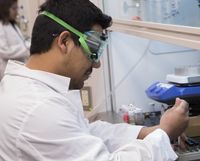It’s a relatively new focus in the science world, but for University of New Mexico Assistant Professor Ramesh Giri, ‘sustainable chemistry’ has proven to be a very worthwhile area of research.
Giri’s work, which aims at developing a new technique to perform valuable cross-coupling reactions using a new catalyst, was recently selected for a CAREER Award from the National Science Foundation (NSF). The award is widely considered one of the most competitive in the country for junior faculty.

“When I saw the email that said my research was going to be recommended for funding by the NSF, I just couldn’t say anything, I was so excited. It was one of the best days of my life,” Giri said.
The award, $675,000 over five years, is the first major grant the scientist has received as a faculty member and will go a long way in bolstering the research Giri and his group are working on. The funding will allow him to hire an additional undergraduate research assistant and continue to strengthen the overall project. He said seeing his student’s reaction to the news has been one of the most rewarding parts of the process.
Giri, who is originally from Nepal and started at UNM in 2012, has also been working with the South Valley Academy, an Albuquerque area charter school, to reach out to students interested in chemistry. He plans to use a portion of the grant to hire three local high school students to work in his lab over the summer and learn more about science in a hands on way. He also collaborates with the UNM College Enrichment and Outreach Program to involve students from traditionally underrepresented groups.
He said this award is one of the major highlights in his academic career so far, but adds, he couldn’t have done it without the support of his students and the department.
“I have received so much support from the chemistry department and the dean’s office, so I’d really like to thank everyone for all their enthusiastic support of this work we’re doing,” Giri said.

Copper Catalyzed Cross-Coupling
Giri’s proposal, ‘Development of Tandem and Multi-Component Couplings with Base Metals and Organic Electron Donors,’ has the potential to have a huge impact in the pharmaceutical industry and the chemistry world as a whole.

“These reactions are widely used in the pharmaceutical industry, making all kinds of marketed drugs. I don’t think there is any area where it cannot be used,” he explained. “But, most of them use palladium and we don’t have much palladium on this planet.”
Because of this issue, Giri is working on a method to replace palladium in these cross-coupling reactions with copper (Cu) as the catalyst.
“We are still developing this new method, but we have gotten a lot of great results so far and have published about 14 papers in this area already,” Giri said.
The benefits to using copper in these reactions would be significant for scientists all over the world. Copper is much less expensive and widely available. It is also less toxic to our bodies and much easier to remove from a finished product.
However, even though Cu and Pd are both transition metals on the periodic table, they don’t necessarily have the same elemental properties, nor do they react in the same way when used in synthesis.
“Using copper [in these reactions] is not easy,” said Giri. “It’s very difficult to work with in terms of developing these reactions and investigating their reaction mechanisms.”
But, given the success Giri has had so far with this method, he is confident the copper-catalyzed cross-coupling reactions are a real possibility in the near future.
“This is very exciting and I’m very happy to be able to work on this kind of research here at UNM.”